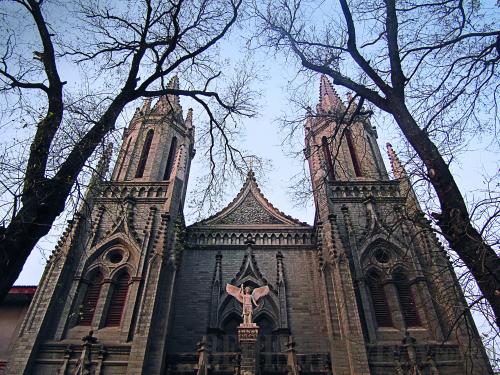|
 |
|
St. Michael's Church (LIU JIAN) |
Beijing hutongs (old lanes or alleys) enjoy a special place in the rich cultural tapestry of China's capital. While their construction may not be considered as elite as the architecture of the Forbidden City, they are witnesses to Beijing's evolution over the years. Each has its own story, its own connection to important historical events.
Rapid real estate development in recent years has led to their increasing absence on city maps. Many local residents worry about the future of hutongs, whose existence serve as a living memory of old Beijing.
ChinAfrica will explore Beijing's vanishing hutongs in an effort to record and preserve their legacy. Foreign-flavored Dongjiaominxiang Alley, the capital's longest hutong, and the century-old Xijiaominxiang Alley, Beijing's former financial street are spotlighted this issue. They both run parallel to and south of Chang'an Avenue in the city's Dongcheng District.
Dongjiaominxiang Alley:
Beijing's longest hutong
Stretching 1,552 meters just southeast of Tiananmen Square, Dongjiaominxiang Alley is known as Beijing's longest hutong.
Its history can be traced back to the Yuan Dynasty (1271-1368). Originally, it was connected with Xijiaominxiang Alley to the west of Tiananmen Square. As a strategic part of the country's rice trade route, it garnered the name Jiangmixiang Alley (which literally translates to "rice alley"). In the following Ming (1368-1644) and Qing (1644-1911) dynasties, it was home to imperial ministry offices and served as the country's diplomatic center for many years.
After 1900, with the arrival of the international community, Dongjiaominxiang Alley was designated as an embassy zone. Called "Beijing Legation Quarter," it was known as "a kingdom inside a kingdom," housing the embassies of France, Japan, the United States, Germany, Russia, Belgium, Holland, Italy and Austria. Many foreign banks, hospitals and post offices also operated here, which explains the various Western-style structures scattered on both sides of the alley.
After the founding of the People's Republic of China in 1949, the area continued to serve as a diplomatic zone until the late 1950s when the embassies were moved further east. Some of the century-old buildings have been preserved and re-purposed, such as the former Italian Embassy, which now houses the Chinese People's Association for Friendship with Foreign Countries.
Xijiaominxiang Alley:
Beijing's former financial street
While Dongjiaominxiang Alley was known for its diplomatic function, Xijiaominxiang Alley played more of an important role in banking. Many international and domestic banks chose the alley as the site in which to house their headquarters. It became a time-honored lane of big banks.
Today, the buildings are listed as cultural relics protected by the Beijing Municipal Government. These include the former Central Bank (built in the 1930s, it's now the gold coin franchised retailer Fangquanzhai), the former Commercial Guarantee Bank of China (presently a numismatic museum) and the former Continental Bank (currently a sub-branch of the Bank of China).
What to see in the Hutongs
>St. Michael's Church
Even in a hutong full of foreign architecture, St. Michael's Church still stands out. Built in the European Gothic-style, by a French priest in 1901, St. Michael's continues to hold daily masses in the present day.
Address: No.13 Dongjiaominxiang Alley
> Beijing Police Museum
This museum provides a fascinating insight into Beijing's underworld. It occupies a former Citibank building outfitted with an original wrought iron elevator.
Address: No.36 Dongjiaominxiang Alley
Admission: 5 yuan
Hours: 9 a.m.-4 p.m. Tue.-Sun.
> China Numismatic Museum
This intriguing three-floor museum traces the development of money production in China, from the spade-shaped coins of the Spring and Autumn Period (770-476 B.C.) to coinage and paper currency in the modern era. It's the site of the former Commercial Guarantee Bank of China, a typical modern bank building completed in the 1930s.
Address: No.17 Xijiaominxiang Alley
Admission: 10 yuan
Hours: 9 a.m.- 4 p.m. Tue.-Sun. |